Francis Drake Worksheets
Do you want to save dozens of hours in time? Get your evenings and weekends back? Be able to teach about Francis Drake to your students?
Our worksheet bundle includes a fact file and printable worksheets and student activities. Perfect for both the classroom and homeschooling!
Resource Examples
Click any of the example images below to view a larger version.
Fact File
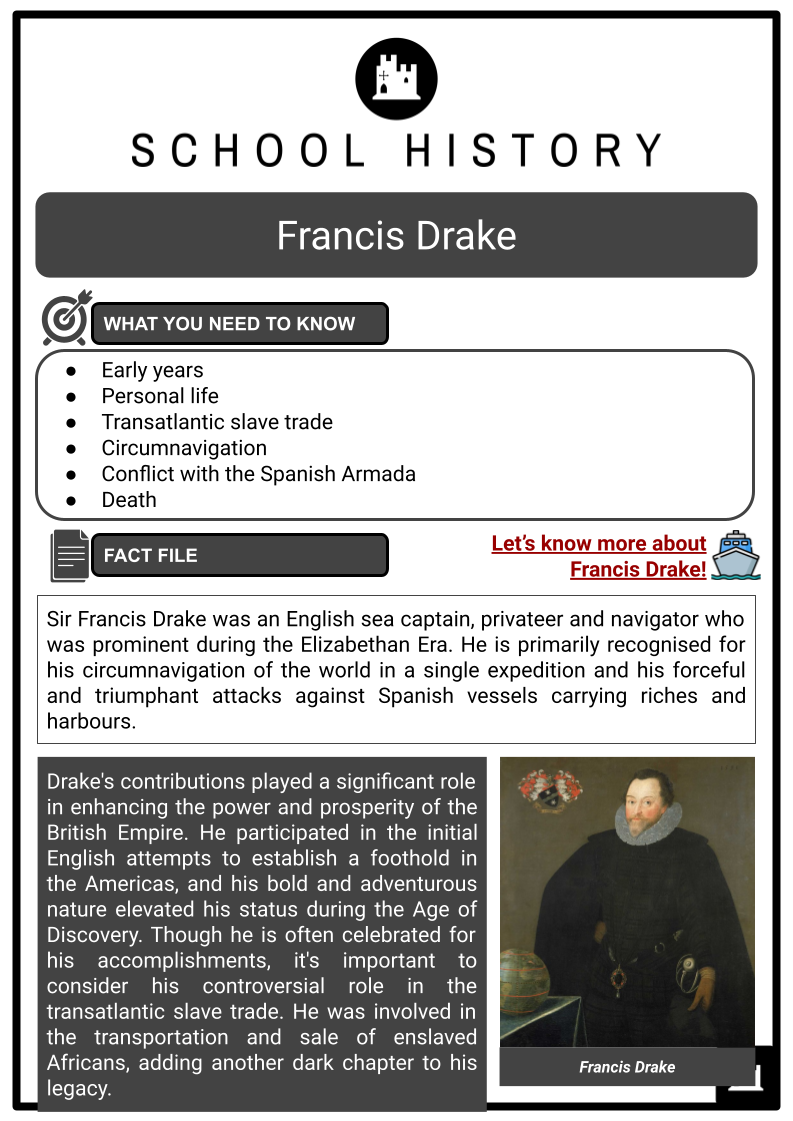
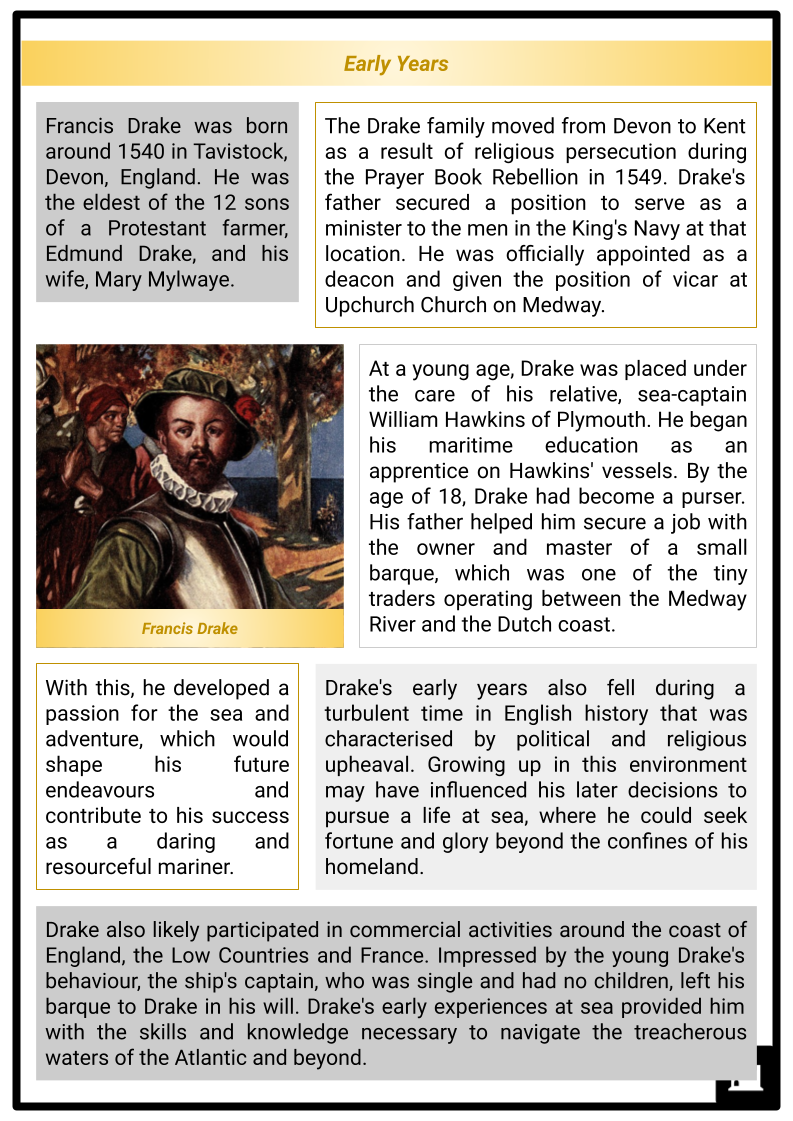
Student Activities
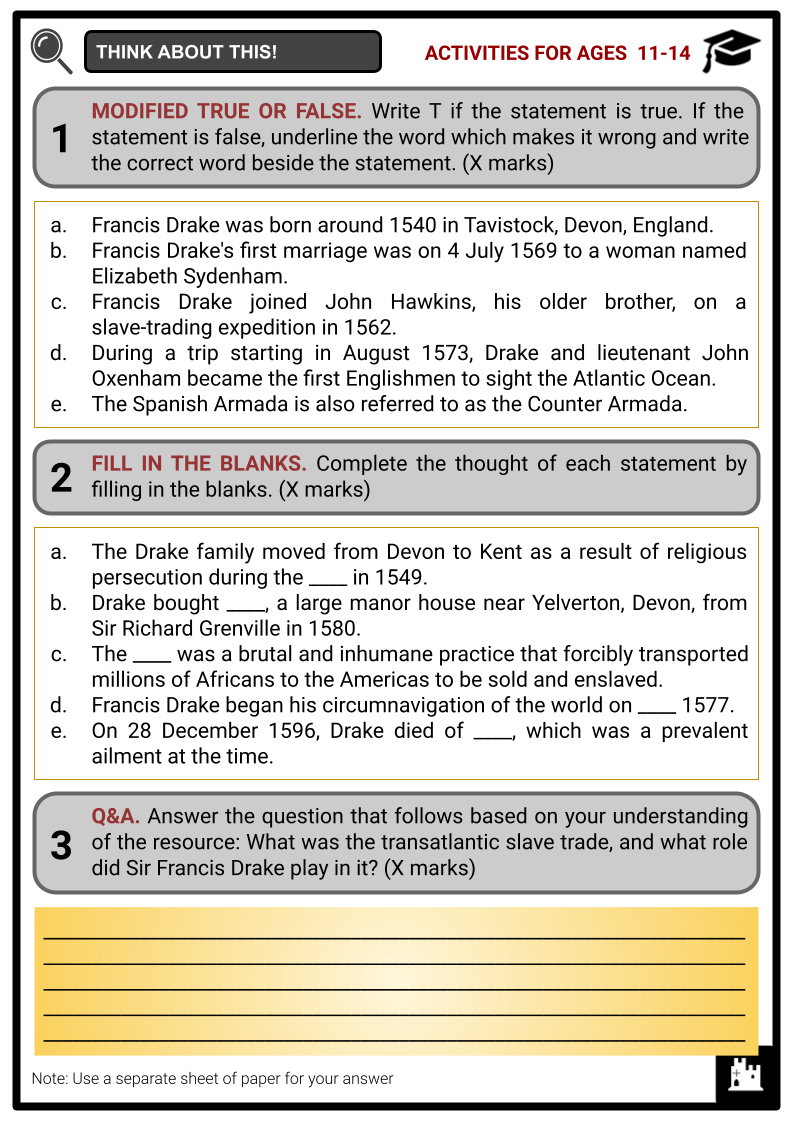
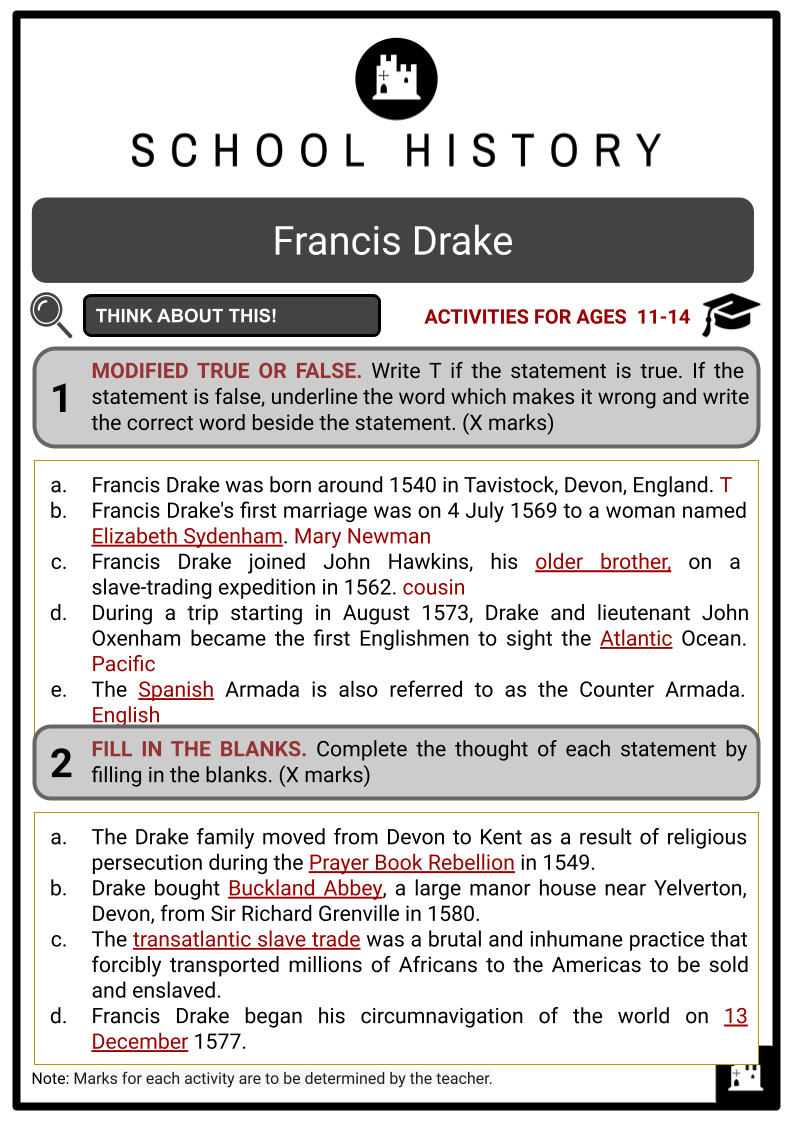
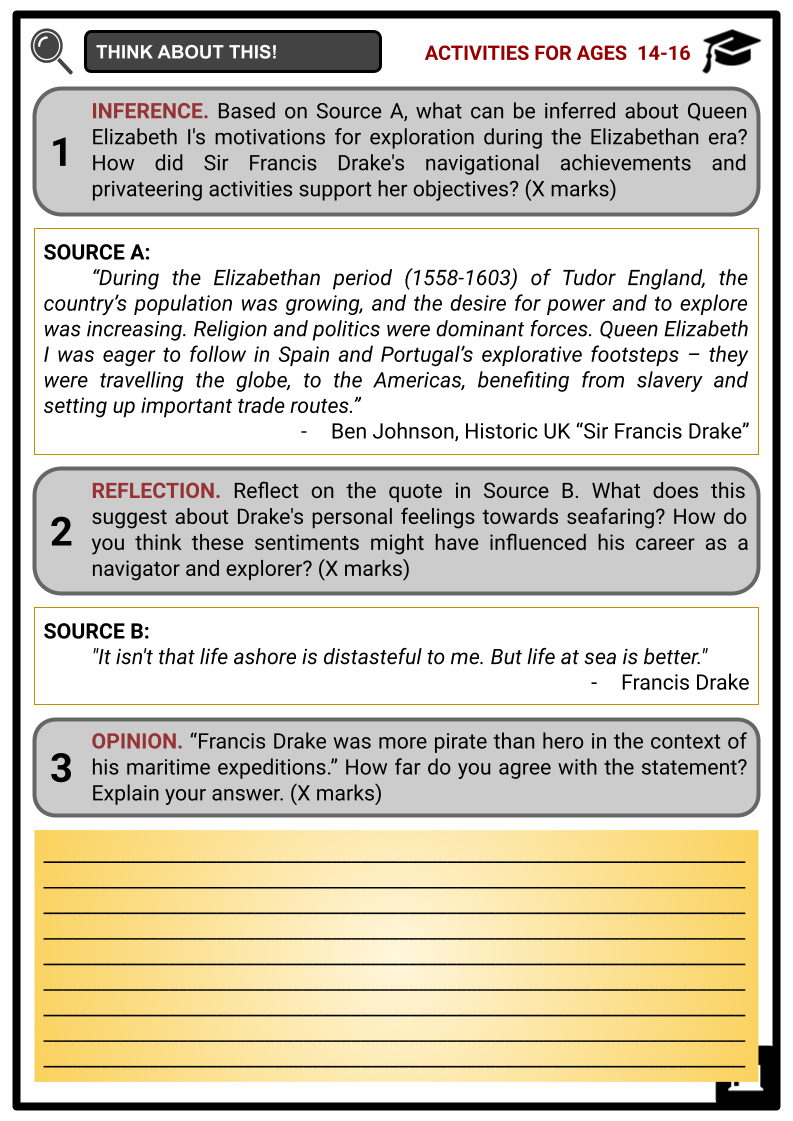
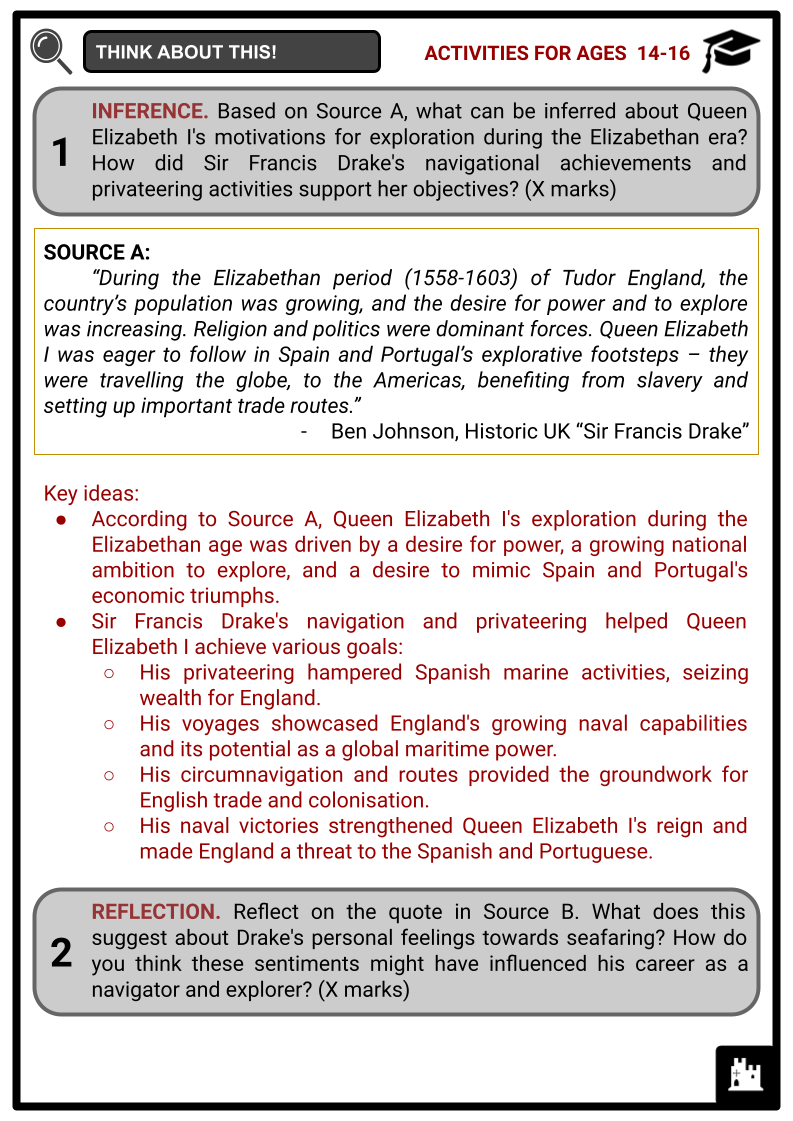
Summary
- Early years
- Personal life
- Transatlantic slave trade
- Circumnavigation
- Conflict with the Spanish Armada
- Death
Key Facts And Information
Let’s know more about Francis Drake!
Sir Francis Drake was an English sea captain, privateer and navigator who was prominent during the Elizabethan Era. He is primarily recognised for his circumnavigation of the world in a single expedition and his forceful and triumphant attacks against Spanish vessels carrying riches and harbours.
Drake's contributions played a significant role in enhancing the power and prosperity of the British Empire. He participated in the initial English attempts to establish a foothold in the Americas, and his bold and adventurous nature elevated his status during the Age of Discovery. Though he is often celebrated for his accomplishments, it's important to consider his controversial role in the transatlantic slave trade. He was involved in the transportation and sale of enslaved Africans, adding another dark chapter to his legacy.
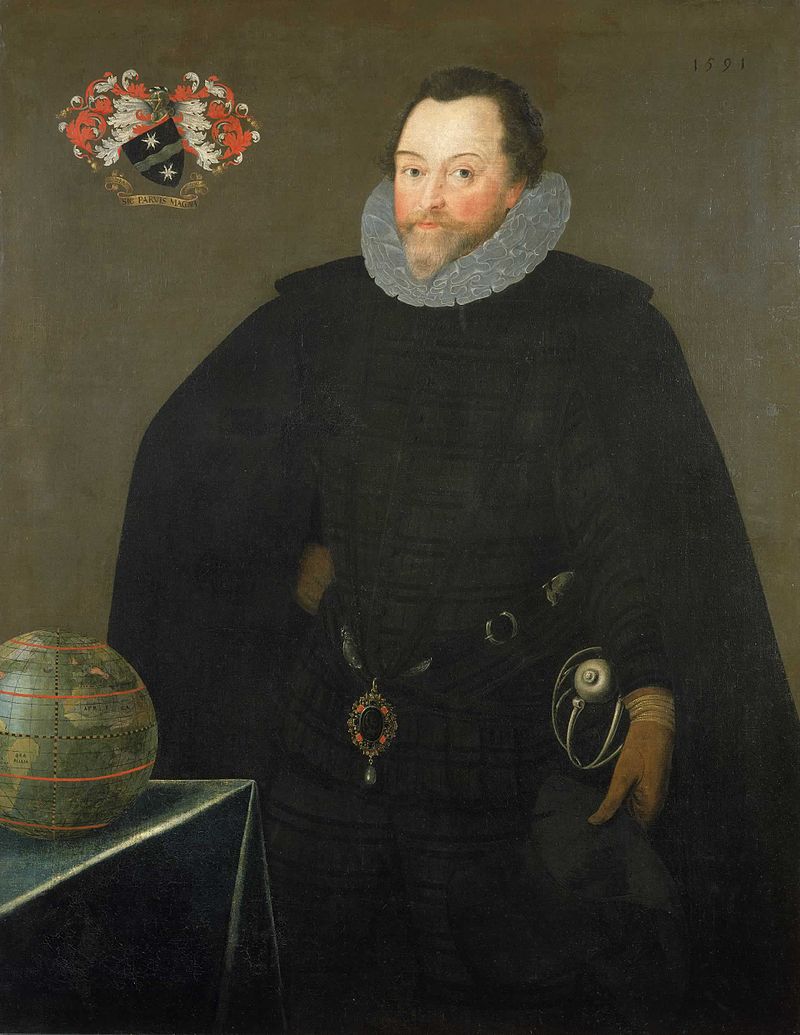
Early Years
- Francis Drake was born around 1540 in Tavistock, Devon, England. He was the eldest of the 12 sons of a Protestant farmer, Edmund Drake, and his wife, Mary Mylwaye.
- The Drake family moved from Devon to Kent as a result of religious persecution during the Prayer Book Rebellion in 1549. Drake's father secured a position to serve as a minister to the men in the King's Navy at that location. He was officially appointed as a deacon and given the position of vicar at Upchurch Church on Medway.
- At a young age, Drake was placed under the care of his relative, sea-captain William Hawkins of Plymouth. He began his maritime education as an apprentice on Hawkins' vessels. By the age of 18, Drake had become a purser. His father helped him secure a job with the owner and master of a small barque, which was one of the tiny traders operating between the Medway River and the Dutch coast.
- With this, he developed a passion for the sea and adventure, which would shape his future endeavours and contribute to his success as a daring and resourceful mariner.
- Drake's early years also fell during a turbulent time in English history that was characterised by political and religious upheaval. Growing up in this environment may have influenced his later decisions to pursue a life at sea, where he could seek fortune and glory beyond the confines of his homeland.
- Drake also likely participated in commercial activities around the coast of England, the Low Countries and France. Impressed by the young Drake's behaviour, the ship's captain, who was single and had no children, left his barque to Drake in his will. Drake's early experiences at sea provided him with the skills and knowledge necessary to navigate the treacherous waters of the Atlantic and beyond.
Personal Life
- While little is known about his personal relationships, it is believed that Francis Drake married twice and had no children. His first marriage was on 4 July 1569 to a woman named Mary Newman, who tragically died on 24 January 1583. Drake's second marriage was in 1585 to Elizabeth Sydenham, a wealthy widow.
- Despite his marriages, it is widely acknowledged that Drake's true love was the sea. He spent most of his time at sea, seeking adventure and fame as an intrepid navigator.
- Drake bought Buckland Abbey, a large manor house near Yelverton, Devon, from Sir Richard Grenville in 1580. A number of his mementos are on display at Buckland Abbey, where he lived for 15 years until his final voyage. His family owned it until 1946.
- His coat of arms and full achievement are portrayed in the shape of a massive, painted plaster overmantel in the Lifetimes Gallery at Buckland Abbey.
- Drake's personal life paralleled his goals. His pursuit of fortune and fame led him on dangerous trips. His unwavering dedication to his aims defined his personal life and made him a bold marine pioneer.
Transatlantic Slave Trade
- Francis Drake made his first major mark on the transatlantic slave trade when he participated in a slave-trading expedition to the Caribbean. The transatlantic slave trade was a brutal and inhumane practice that forcibly transported millions of Africans to the Americas to be sold and enslaved.
- Drake joined John Hawkins, his cousin, on a slave-trading expedition in 1562. The first expedition's profitability allowed a second slave voyage in 1564 that gained the support of Queen Elizabeth I.
- The Queen lent one of her ships, the Jesus of Lübeck, to be used in the voyage as a sign of her endorsement of the voyage.
- When the Spanish and Portuguese got angry that the English were selling enslaved people to their colonies despite this being outlawed, Queen Elizabeth I forbade Hawkins from carrying out a third slave voyage in order to avert war. In response, Hawkins organised a slave trip in 1566, with John Lovell in command and Drake joining him. Unfortunately, the voyage failed, with over 90 enslaved Africans freed without payment.
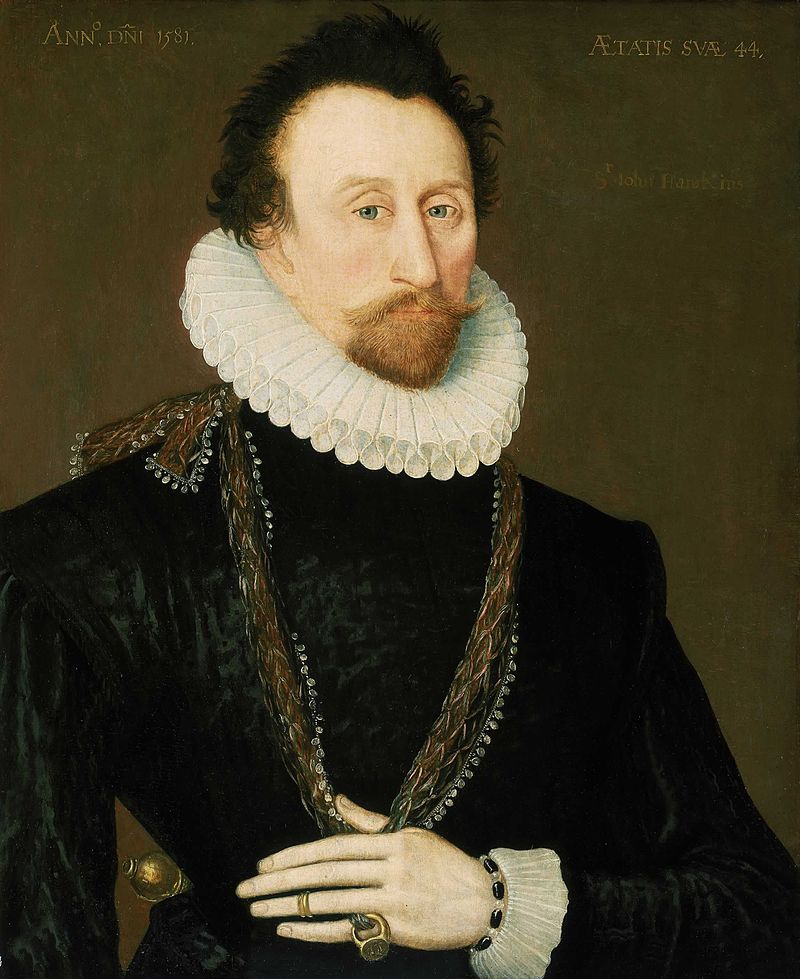
- In 1567, Drake participated in one last major slave-trading expedition with Hawkins. In this expedition, they attacked the Spanish port of San Juan de Ulúa in present-day Mexico. The English lost all but two ships in the conflict. The Spanish fired a fireship against the Jesus of Lübeck, but Drake escaped, leaving Hawkins to flee and stagger back to England with 15 men after losing dozens of troops. There were a large number of abandoned English sailors.
- Hawkins accused Drake of desertion and of stealing their wealth after returning to England. Drake said he had shared all profits with the crew and thought Hawkins was lost when he left. After the terrible end of their fourth voyage, Drake decided to attack Spanish possessions instead of trading and enslaving.
- Drake's last slave-trading expedition was from 1567 to 1569. It consisted of four trips that enslaved 1,200 Africans and killed three times as many. His involvement in the transatlantic slave trade raises significant ethical controversy surrounding his legacy. His participation in the exploitation and trafficking of enslaved Africans raises moral questions about his actions and their consequences.
Circumnavigation
- Drake began his independent business in 1572 as he planned to invade the Isthmus of Panama. At this point, Peru's silver and gold wealth had to be carried ashore and transported overland to the Caribbean Sea, where Spanish galleons would transfer it at Nombre de Dios. Drake and 73 men departed Plymouth on 24 May 1572 in two small ships to conquer Nombre de Dios.
- His first raid was in late July 1572. Although he conquered Nombre de Dios, the Spanish from Panama wounded him seriously, forcing him to withdraw without the royal treasury's gold, silver, pearls and jewels.
- Nonetheless, he later became wealthy and famous after capturing the Spanish silver train at Nombre de Dios on 1 April 1573. Drake and his party captured 20 tonnes of silver and gold after the attack on the train.
- During a trip starting in August 1573, Drake and lieutenant John Oxenham became the first Englishmen to sight the Pacific Ocean on 11 February. After the raids, Drake returned to Plymouth, but the government made a truce with King Philip II of Spain, preventing it from recognising Drake's achievement. For his raids, Drake was a hero in England and a pirate in Spain.
- After the Panama Isthmus raid, Francis Walsingham, Robert Dudley, 1st Earl of Leicester, John Hawkins, Christopher Hatton and Drake organised and funded Drake's voyage along the Pacific coast of the Americas against the Spanish. The circumnavigation expedition, which lasted from 1577 to 1580, represented a bold and ambitious endeavour to explore new trade routes and expand English influence across the world.
Timeline of Francis Drake's Circumnavigation
1577
- Francis Drake begins his circumnavigation of the world on 13 December 1577.
- He sets sail from Plymouth, England, heading into the Atlantic with five ships and about 160 men on board.
- Ships of Drake's raiding expedition: Golden Hind/Pelican (led by Francis Drake), Elizabeth (led by John Wynter), Marigold (led by John Thomas), Benedict (led by Thomas Moon) and Swan (led by John Chester).
1578
- Drake arrives from Western Africa off Porto Alegre.
- His fleet enters the Strait of Magellan and crosses it in just 14 days due to favourable winds.
- They loot Valparaíso, Chile, and capture a ship with wealth and maps of the Pacific.
1579
- Drake's remaining ship, the Golden Hind, captures a Spanish treasure ship off the coast of what is present-day Ecuador.
- His fleet leaves the Americas, setting sail for Mindanao.
- His crew sails across the Pacific Ocean and reaches the Moluccas (the Spice Islands).
1580
- Drake reaches Java.
- His fleet navigates the Indian Ocean and rounds the Cape of Good Hope.
- His crew navigates back to Plymouth, England, successfully completing their circumnavigation of the world on 26 September.
- Drake is honoured by Queen Elizabeth I with £10,000 and a knighthood the year after.
Conflict with the Spanish Armada
- In addition to his circumnavigation, Francis Drake's conflict with the Spanish Armada further exemplifies his role in maritime exploration and colonial expansion. By the end of the 16th century, relations between England and Spain declined due to the English piracy against Spanish ships, Elizabeth I's support for the Dutch rebellions, and the execution of the Catholic Mary, Queen of Scots.
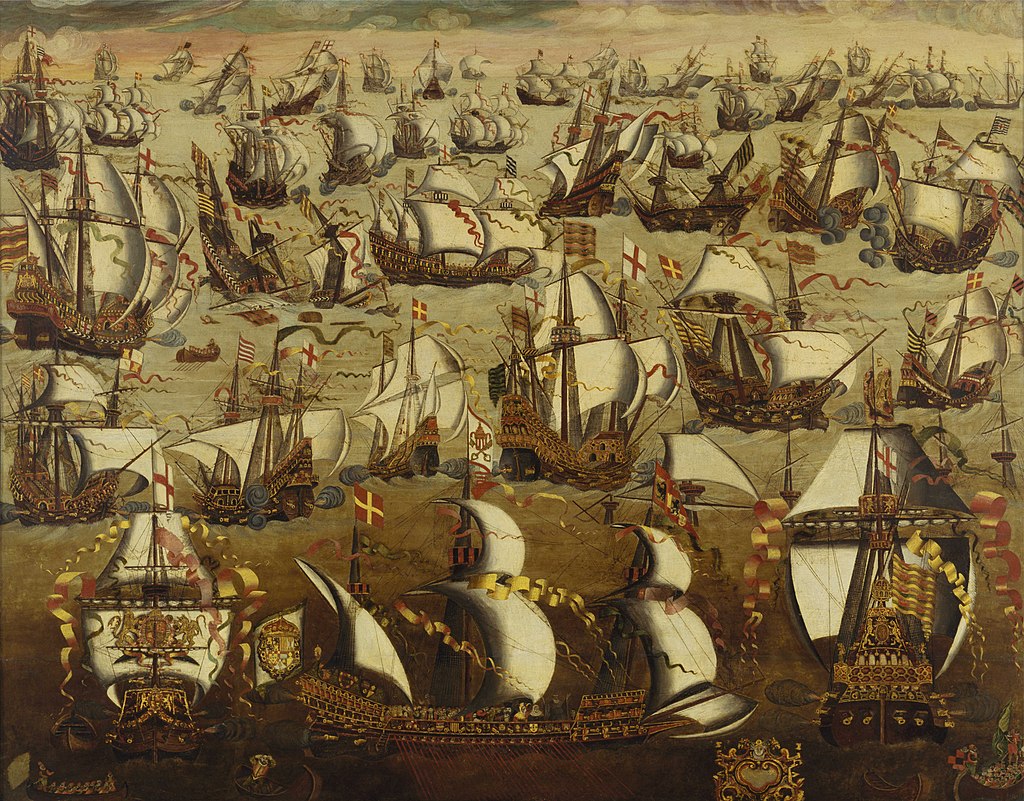
- Philip II of Spain, who initially favoured the Protestant queen, made it his objective to conquer England and restore it to Catholicism. He started the Spanish Armada, which Elizabeth I's Royal Navy fought in the English Channel.
- Pre-conflict, Drake had already earned a reputation as a formidable sailor, as his earlier exploits had caused significant disruption to Spanish interests in the Americas, particularly his successful attacks on Spanish treasure fleets.
- In 1587, Drake launched a preemptive strike at the port of Cadiz, delaying the Spanish invasion plan by destroying a large number of ships that were being prepared for the Armada.
- In 1588, he set sail to invade England and overthrow Queen Elizabeth I. The Spanish fleet consisted of 130 ships, and its primary goal was to escort an army from Flanders to England. When the Spanish Armada entered the English Channel, the English navy, which included Drake as vice admiral, engaged in a series of tactical manoeuvres and battles.
- The Spanish Armada was ultimately defeated due to a combination of the English navy's effective tactics, driven by commanders like Drake, and poor weather conditions, which inflicted significant damage on the Spanish ships as they attempted to return home via the North Atlantic.
- In 1589, after the defeat of the Spanish Armada, England sought to capitalise on Spain's weakened naval status. The plan was to deliver a crippling blow to Spain by destroying the remaining Spanish fleet and supporting a rebellion in Portugal, which was under Spanish rule.
- The English Armada, also referred to as the Counter Armada, was a naval and military expedition under the command of Sir Francis Drake as admiral and Sir John Norreys as the troops' general.
- The English force failed to capture the Spanish ports of La Coruña and Lisbon. Unable to incite a Portuguese uprising and capture Lisbon, and after experiencing losses, the armada withdrew. The mission was a considerable failure and disaster for England, resulting in high casualties and financial losses. It negatively affected Drake's previously esteemed reputation.
Death
- Francis Drake worked at sea until his mid-50s. He lost the Battle of San Juan de Puerto Rico after failing to take Las Palmas in 1595 and losing several battles in Spanish America. Although Spanish gunners from El Morro Castle shot a cannonball through his stateroom on the expedition's flagship, Drake was able to survive.
- On 28 December 1596, Drake died of dysentery, which was a prevalent ailment at the time. He died while anchored off Portobelo, where some Spanish treasure ships had taken shelter. The English fleet withdrew after his death.
- Drake was buried at sea in a lead-lined coffin near Portobelo, a few miles offshore. His grave is said to be near the ruins of the Elizabeth and the Delight, two British ships destroyed in Portobelo Bay.
Image Sources
- https://upload.wikimedia.org/wikipedia/commons/thumb/7/7d/Gheeraerts_Francis_Drake_1591.jpg/800px-Gheeraerts_Francis_Drake_1591.jpg
- https://upload.wikimedia.org/wikipedia/commons/thumb/0/00/John_Hawkins.JPG/800px-John_Hawkins.JPG
- https://upload.wikimedia.org/wikipedia/commons/thumb/1/1d/English_Ships_and_the_Spanish_Armada%2C_August_1588_RMG_BHC0262.jpg/1024px-English_Ships_and_the_Spanish_Armada%2C_August_1588_RMG_BHC0262.jpg
Frequently Asked Questions
- Who was Francis Drake?
Francis Drake was an English explorer, privateer, and naval officer who lived during the Elizabethan Era. He is best known for his circumnavigation of the world and his raids on Spanish settlements and ships.
- What were some of Francis Drake's notable voyages?
Apart from his circumnavigation of the globe, Drake undertook several significant voyages, including his raids on Spanish ships and the Spanish Main, his capture of Spanish treasure in the Americas, and his involvement in the defeat of the Spanish Armada in 1588.
- Was Francis Drake a pirate?
While some consider Drake's actions piracy, Queen Elizabeth I officially sanctioned him as a privateer, essentially a state-sanctioned pirate authorised to attack and plunder enemy ships and settlements.
